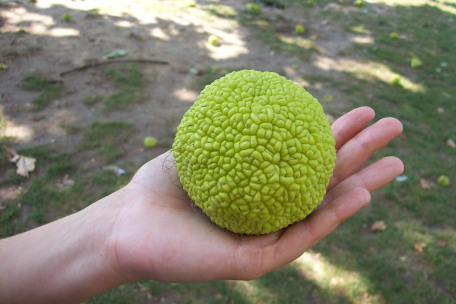When I was home last Christmas visiting my parents in southeast Ohio, I was walking along the forest perimeter near their house and came upon an Osage orange (Maclura pomifera) tree. For my friends in the Northeast who aren’t acquainted with this tree (it’s less common up here), this is what an Osage orange looks like:

These trees, which surprisingly are related to mulberries, are from the south-central US and are planted in areas beyond that, such as the Midwest, because it’s a hardy tree that is useful for the formation of natural hedges. Its fruit, on the other hand, is regarded as useless and unappealing due to its peculiar texture and sticky sap.
Ever since my successful experiments with making crabapple wine, I’ve been interested in the possibility of creating more wines made with “unwanted” fruit. These Osage oranges seemed like the perfect opportunity for such an experiment, so I filled a couple of 5-gallon buckets with the frozen fruits and hauled them back to New York with me.
The first thing I noticed during the brew was the way that the sticky sap from the fruit would get stuck on the pot during the initial boiling of the fruit, proving challenging to remove. It stuck even more steadfastly to the primary fermentation bucket, which I wound up having to discard because it became clear I would never get the sap off. Sap management is clearly going to be a major part of the process if I ever make another batch of this stuff.
Despite the trouble that went into the initial part of the brew, the wine wound up clarifying after spending enough time in my carboy, and the end product is quite appealing. I recently moved into The Basswood housing co-op (more on that in a future post) and we threw a party over the weekend, so I had an opportunity to do a taste test with some of the guests. They were eager to try the wine and described it using terms like “citrusy”, “cider-like”, “tart”, “white”, and “complex”. Overall, I encourage others to experiment with Osage orange wine and see what they can accomplish.
There are no existing recipes for Osage orange wine as far as I can discern, so I had to come up with my own. I decided to loosely base my recipe on Jack Keller’s Texas mulberry wine recipe since the two plants are related, but I don’t have detailed information of the Osage orange fruit’s chemistry right now can can’t be sure that my recipe is optimal. Nonetheless, it works. Here it is:
- 12 pounds Osage orange fruit (chopped)
- 3 gallons water
- 13.5 cups of sugar
- 3 teaspoons yeast nutrient
- 3 teaspoons acid blend
- 3 teaspoons pectic enzyme
- 3 Campden tablets
- 1 packet Bordeaux wine yeast
Put water, fruit and sugar in a pot and boil until the fruit becomes gray and mushy. Pour into your primary fermentation vessel and add yeast nutrient, acid blend, pectic enzyme and Campden tablets, then let cool overnight. Add wine yeast and allow to ferment until bubbling stops, then transfer to an airlocked secondary fermentation vessel for aging.


Comments
August 8, 2024 11:35
Hopkins Liquor Collection proudly presents Macallan 50, a whisky of remarkable distinction. This exceptional single malt offers a rich tapestry of flavors, including hints of dried fruits, vanilla, and spice, all perfectly balanced by years of maturation. Ideal for discerning palates, Macallan 50 is a true celebration of whisky artistry. Explore our curated selection and indulge in the timeless luxury of this extraordinary spirit. Macallan 50
August 8, 2024 11:42
Hopkins Liquor Collection proudly presents Macallan 50, a whisky of remarkable distinction. This exceptional single malt offers a rich tapestry of flavors, including hints of dried fruits, vanilla, and spice, all perfectly balanced by years of maturation. Ideal for discerning palates, Macallan 50 is a true celebration of whisky artistry. Explore our curated selection and indulge in the timeless luxury of this extraordinary spirit.